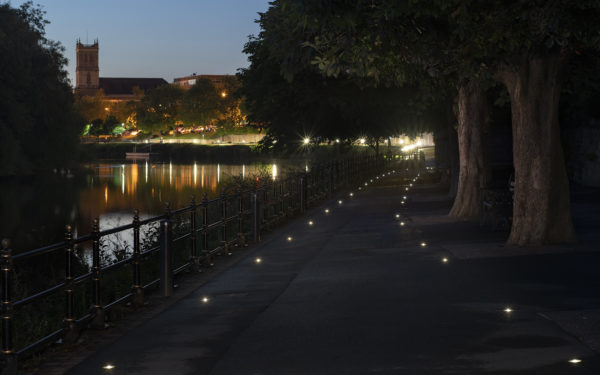All year-round use for Cambridge cycle path thanks to environmentally friendly solar lighting.
With bike-friendly city planning, cycle schemes and charity cycle campaigns it’s no surprise that the city of Cambridge is a hub for cycling.
In fact, it is thought that Cambridge has the highest level of cycling in the country with one in three residents choosing to cycle to work (Cambridge City Council, 2018)¹.
Coe Fen is a shared footpath in the east of the city and a key commuter cycling route into the centre. Designated as a city wildlife site in 1996, Coe Fen is also home to a variety of bat species including Common Pipistrelle, Soprano Pipistrelle, Daubenton’s, Noctule, Serotine and Brown long-eared bats.
The challenge
Cambridge City Council were undertaking a scheme to improve facilities for cyclists and pedestrians on Coe Fen public right of way. With public safety in mind and to encourage more people to use the footpath, the need for wayfinding light had been recognised.
However, within the context of a declining bat population in the UK over the last century (Bat Conservation Trust, 2018)², Cambridge City Council had a moral and legal obligation to ensure that any changes to the historic, unique and natural landscape of Coe Fen were not at the detriment of the local wildlife.
Cambridge City Council therefore needed to ensure that the measures to improve cycling infrastructure, safety and wayfinding were sensitive to the ecology of the area.
The solution
Cambridge City Council worked with Solareye to install more than one hundred environmentally friendly solar ground lights across a stretch of Coe Fen, measuring approximately 900m.
The solareye80 product was chosen as it avoids high levels of light spill that could affect nocturnal animals, whilst providing a low cost renewably sourced level of light for cyclists and pedestrians to safely use the path during night time hours.
Each Solareye was also fitted with a ‘Bat Hat’ specifically designed to reduce the upward light spillage by 98%, further reducing the lights’ impact on local wildlife. For areas known to be popular feeding coridoors, the pathway was left entirely free of lights so as not to disturb the bats unduly.
The benefits
Illuminating Coe Fen has helped pave the way for cyclists and pedestrians whilst reducing public safety concerns. Installing the solar ground lights has opened the path for year-round use thereby helping to encourage more people to use the public right of way at night.
“Due to the success of the lighting through Coe Fen; solar lighting with bat hat protection has become the method with greatest community backing for schemes in similar environments across the city.
As a consequence of the Coe Fen project a further 250m of solar lighting has now been extended along the route bringing the length of wayfinding lighting along this route to well-over 1km.”
– Officer working for Cambridge City Council
Want to find out more?
If you have an area that requires night time delineation, installation of the Solareye80 is:
- – Quick and cost effective with minimal disruption
- – Easy to maintain
- – Suitable for areas off the national grid
- – CE accredited, IP68 and IK10 certified
- – Environmentally Friendly
To download this case study as a PDF click here. If you would like to find out whether Solareyes are right for your project please get in touch with our specialists by calling 0845 293 8062 or completing our online form here.
Sources
1. www.cambridge.gov.uk/cycling-and-walking-schemes
2. www.bats.org.uk/pages/bats_and_lighting.html


